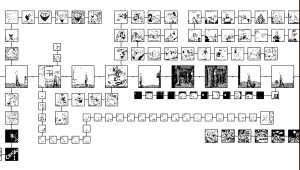Anyone who has been to my house can attest to the fact that it looks like an overflowing library. Books and literary magazines overflow from all of my shelves, and are stacked atop virtually every piece of furniture. And while I absolutely won’t be sold on the idea that the book is a dying art form, I’m equally interested in the possibilities of digital literature. Here are a couple of innovative uses of the internet, online communities, and multimedia in the literary field that I have been following lately.
Neil Gaiman’s “A Calendar of Tales”
Neil Gaiman is the critically acclaimed author of books such as American Gods and The Sandman series of graphic novels, as well as the award-winning children’s books The Graveyard Book and Coraline. Gaiman is one of the popular authors who has taken to the online environment easily, maintaining Facebook, Tumblr, and blog that contribute to a well-developed personal brand. He is active and engaging on Twitter (@neilhimself), and uses his account much more for amusing commentary than self-promotion. He is especially adept at connecting with fans online, and regularly publishes short stories for free on his personal website.
“A Calendar of Tales” is his latest project, in which he crowdsourced inspiration via his Twitter feed.
The finished stories are now available for free both on Soundcloud as audio files and as a downloadable .pdf document. But the project doesn’t end there. Since the stories have been released, he is now inviting fans to make artwork inspired by them, in hopes of creating a physical calendar to correspond with the stories. This type of community interaction is the kind of collaboration I think we’ll be seeing more of as writers continue to fully embrace the possibilities of creating work online.
Resurrecting Hypertext Fiction
Readers who recall the early days of the internet or are interested in digital literature may have seen hypertext stories. But for those who haven’t, they are fictional works that take advantage of digital possibilities, often by means of clickable text within the work. Some use typography to convey a point, and some take advantage of multimedia by incorporating sounds (either as background music, or initiated by the reader’s click) and animation. Many take the form of an online version of the “Choose Your Own Adventure” series, wherein the reader can actually interact with the text by choosing from a given list of possible actions, as in this story, “24 Hours.” This technique has even been applied to make flash fiction (very short stories) interactive, as in “The Mating Ritual of the Modern Man” which is one of 100 such hypertext pieces.

Though many aspects of hypertext fiction persist in other areas, such as the use of linked text in blogging, it is largely an artifact of the past.This medium has generally been left behind, as many experiments are, though not necessarily because it is a bad idea in principle. Author Paul LaFarge notes in his Salon article about the subject that a big reason for hypertext fiction’s failure is the fact that few serious writers used it, so the pieces were largely written by amateurs and nonwriters. This was in the 90s, when many academics were still suspicious of the notion of literally anyone being able to create content. Many hypertext pieces failed the logistical task of rendering complex, nonlinear stories with many possible endings easy to navigate, some pieces simply over-used the tools, creating a web design disaster all too common of the era.
Despite these hurdles, LaFarge is one of the serious writers who is revisiting the medium. His book Luminous Airplanes is available in both hardcover and what his publishers call “immersive text” format (in an attempt to beat hypertext’s bad rap), and has so far received favorable criticism. Readers are encouraged to visit the corresponding website for the fullest experience of the story. The site contains a map with extra information that helps the reader navigate the story and its branching-off points.
